










BY DAVE NIELSEN HBA CEO

If you’re reading this, chances are you (or your company) are an HBA member.
But did you know that even though our HBA represents all residential construction, as well as housing-related commercial contractors, less than 3% of all residential general and specialty contractors in our market are members?
Most of the non-members are smaller businesses. These are hard ones for HBA to reach directly. However, you likely know several. HBA provides a lot of value to smaller contractors. We regularly communicate info on changing building and development policies,
requirements, and regulations. We provide training and education resources, some of which are free to members. We advocate regularly to help address permit, inspection, and service issues within our Cities, Counties, Special Districts, and utility providers. We provide fuel, cell phone, medical insurance, workers comp, building materials/supplies, and other product discounts to help businesses add value and save
HBA is holding our big annual Member Drive from October 10-25. We will be offering special incentives to new members for their first year of membership. Dues payment plans start at less than $80/month for small business members.
money. And we help connect members to other companies and resources that can help improve and grow businesses.
If you are a member, thank you. Help us be a stronger resource for you and our industry by encouraging others to join.


BY: PRESTON KORST, HBA DIRECTOR OF PUBLIC POLICY & GOVERNMENT AFFAIRS


For more than a year, the Home Building Association of Greater Portland and Portland General Electric have undergone extensive engagement with industry members to improve customer service, communication, and efficiency in development and construction related issues. Starting with an executive roundtable in September 2023 at PGE’s headquarters in Portland, HBA members and PGE leaders have initiated dozens of conversations ranging on everything from supply chain issues, infrastructure installment, middle housing challenges, permitting needs, customer service improvements, and overall communication about energy consumption trends.
As our industry navigates an evolving housing landscape marked by increased housing costs, rising demand for energy consumption and increased sustainability goals, the partnership between HBA and PGE emerges as increasingly valuable in our shared pursuit to increase cost-effective housing production and energy efficiency. This ongoing partnership is vital for the industry to address the challenges of our region’s housing deficits while also ensuring that both builders and utilities can achieve financial profitability and improved customer interactions.
In our dozens of conversations with HBA members and PGE, we heard concerns from builders about the supply chain’s impact on the timely delivery and installation of essential energization infrastructure—such as streetlights, switchgear, and transformers. Recent delays, primarily caused by national staffing shortages and global supply chain disruptions, have stalled numerous local projects, creating a ripple effect for both homebuilders and homebuyers. This has hindered builders from meeting development and infrastructure installment requirements for new subdivisions, leading to further delays in plat recording and building permit processing, which further complicates development timelines.
As an example of the effect this has on housing costs—a four-week supply chain delay on a project with about 20 homes can result in over $84,000 in carrying costs. In response to these challenges, HBA and PGE are collaborating with more cities to help create more flexible and predictable substantial completion requirements and streamline the permitting process at large.
Another concern we heard was the impact that regional
staffing shortages have had in causing delays when getting homes and projects energized and inspected. When an early development project can’t secure energy, builders will often rely on gas and diesel generators for temporary power, which can add costs of over $100,000. If the delay in obtaining temporary power extends into colder months, expenses can escalate even more to over $1,500 per home each week. Securing permanent power is also essential for cities to conduct final inspections to receive Certificates of Occupancy. Without this, homebuyers may face financial effects ranging from $10,000 to $100,000 per home, impacting mortgage payments and incurring costs from early lock fees or rate extension penalties. For larger projects, cumulative delays can lead to added costs of over $1 million.
To minimize these delays and associated costs, PGE has implemented a demand-ready ordering schedule. By optimizing customer orders and scheduled maintenance projects, they are better able to ensure that the limited supply of available products is prioritized for projects in the development stage that are most ready to acquire and install them. This approach helps streamline operations and improve project efficiency at a time of national disruption.
To further address these challenges, HBA advocates for the expansion of electrical supplier networks nationally, a priority we’ve highlighted during our meetings with Oregon’s congressional delegation in Washington, D.C., over the past two years. Additionally, HBA supports initiatives to streamline local permitting processes, including collaboration with utilities like PGE on improving infrastructure and completion obligations. HBA also encourages the use of PGE’s Line Extension Agreements, which provide financial credits to builders extending electrical service to new residential developments.
Through these many discussions, we’ve found that an early and collaborative approach among builders, cities, and utilities is key to solving supply issues and related costs.
The demand for residential energy is increasing across our region. This is due to several factors including population growth and in-migrating residents, a rise in the number of households, and the uptake of energy-intensive technologies like electric vehicles (EVs) and smart home devices. As urban areas expand and homeowners embrace electrification, this growing demand strains existing infrastructure, requiring utilities to enhance grids and improve energy distribution systems. Additionally, the rising frequency of climate change and extreme weather only underscores the need for reliable energy sources and products.
The rapid growth in electric vehicles and the corresponding need for adequate infrastructure to support EV charging is becoming increasingly important. Builders have shown an interest in understanding how utilities plan to manage the additional load associated with electrification, particularly regarding programs that may offer savings for new homebuyers. In response, PGE has developed several innovative initiatives to help with this surge in demand. PGE’s Smart Thermostat and EV Smart Charging programs have proven especially successful with both builders and homeowners—helping customers save money in exchange for reducing energy consumption during peak events and shifting EV charging times to when energy demand is lower. These programs currently have thousands of users and are growing rapidly. PGE is also enhancing its infrastructure by upgrading substations and expanding generation capacity to ensure system reliability.
More recently, builders and PGE have been addressing challenges stemming from electrical design and the capacity of

vaults and transformers. During discussions, discrepancies were noted between utilities’ electrical designs, the capacity-needs of homes, and alternative products available in the market. Many electrical design issues (as well as supply-chain interruptions) have resulted in some inspection challenges, leading to delays and increased costs. It was felt that the shift toward larger infrastructure requirements, (i.e., vault sizes) was in part driven by market and regulatory changes, rather than just new EV demand. To mitigate these challenges, PGE has reiterated its standards of practice to design team members, and many builders have begun engaging earlier in the design phase and are working closely with their assigned Design Project Managers.
HBA is also facilitating improved communication with PGE by hosting builder-utility meetings and regularly sharing updated staff-territory contact information. PGE continues to emphasize the importance of early engagement with its managers, particularly given recent supply chain challenges. These small but meaningful changes appear to have helped builders achieve more timely project updates, with quicker inspections and approvals.
The collaborative efforts between HBA and PGE extend beyond service infrastructure and design issues to encompass energy efficiency education for both homebuilders and the public. PGE supports HBA’s Building Science Program—a valuable technical resource offered at no cost to members through HBA’s Home Performance Council. This program is dedicated to promoting better building practices and enhancing understanding of modern building science. PGE ‘s support and sponsorship of this work, in addition to the all-electric home tour called Homes of Tomorrow Today (HOTT), is vital to HBA’s mission. Not only does this offer technical expertise to our members, it also educates the public on how our industry is doing its part to build top-quality energy-efficient, and affordable homes in our region.
Additionally, PGE works closely with Energy Trust of Oregon to provide credits for homes to be designed to be solar-ready and EV-ready, making it easier for builders and homeowners to integrate valuable products for home electrification. Lastly, PGE has set ambitious goals to decarbonize its power operations, aiming for at least an 80% reduction in greenhouse gas emissions from the electricity it provides by 2030, with a plan to achieve zero emissions by 2040. To reach these targets, PGE is transitioning to renewable energy sources, electrifying Story continued on page 6
its vehicle fleet, and implementing programs like the Smart Grid that allow customers to choose clean energy and generate two-way energy solutions.
The Portland region is grappling with a growing housing crisis—it’s a problem that requires all stakeholders in the housing market to find innovations that increase housing supply and improve affordability. In this environment, more are recognizing that energy efficiency is not just a luxury but a necessity to ensure that homebuyers can actually afford to live in their homes long-term. And with extreme weather events becoming more common, even more Oregonians are recognizing firsthand the need for high-functioning products and reliable energy sources.
Given that Oregon has one of the nation’s strictest energy codes, HBA builder members are used to blending energy-efficient designs with highperformance appliances. It’s why HBA recognizes the increased importance of energy reliability and affordability; it’s also why our members advocate for a balanced approach to energy choice. This approach includes embracing a variety of energy solutions—such as solar power, natural gas, battery storage,

and renewable hydrogen—as critical components of a sustainable energy portfolio. HBA believes that a diverse and fully-sourced energy mix is essential for improving the resiliency and costeffectiveness of Oregon’s energy market.
It’s no secret that the construction industry is navigating complex challenges—COVID-related supply chain issues, convoluted municipal regulations, constantly shifting building codes, high interest rates, and workforce shortages have all hindered efforts to enhance energy efficiency while increasing housing production. Additionally, the ability to build middle housing—such as duplexes, triplexes, quadplexes, and cottage clusters—adds further complexity, as these builders often face increased regulatory hurdles and design
As homebuilders work to address the housing crisis and climate change, the partnership between HBA and PGE will only become more valuable. By fostering improved service and response times to help with building costs and time frames, as well as greater energy efficiency in homebuilding, we can ensure that our industry remains as resilient as the homes we build. By collaborating with PGE, we will create innovative solutions that address immediate market challenges while also promoting our shared, long-term goals of increased housing production. Together, we are creating a roadmap that not only addresses the housing crisis but also promotes a sustainable, energy-efficient future.










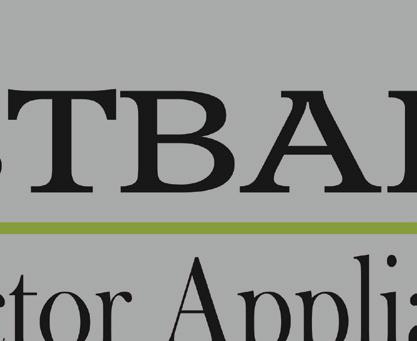



Detailed Product Knowledge from Oregon's Largest Sub Zero & Wolf Builder Supplier
Appliances You'll Find the Very Best Detailed Product Knowledge from Oregon's Largest Sub Zero & Wolf Builder Supplier Experience Quality Trust

Quality Trust 800 SE Hawthorne Blvd just 3 minutes from Downtown Portland 503.954.1192 www.eastbankappliance.com
800 SE Hawthorne Blvd just 3 minutes from Downtown Portland 503.954.1192 www.eastbankappliance.com Open to the Public 8:30
to the Public 8:30 to 5 Mon - Fri Saturdays by Appointment



Visit hbapdx.org/events for the most up-to-date information and event registration details. If you would like to attend a meeting, check in advance to ensure there have been no schedule changes.
October 2
PBUD Council Meeting, 9:00 am, Zoom
October 3
Membership and Retention Committee, 10:00 am, HBA Offices + Zoom
October 7
Past Presidents Committee, 3:00 pm, Zoom
October 9
HPC Council Meeting, 9:30 am, HBA Offices + Zoom
October 16
HBF Executive, 8:30 am, HBA Offices + Zoom
Government Affairs, 10:00 am, HBA Offices + Zoom
October 22
Workforce Development Advisory Board Meeting, 12:00 pm, HBA Offices
October 24
HBA Board of Directors, 11:30 am, HBA Offices
October 31
Halloween
November 6
PBUD Council Meeting, 9:00 am, Zoom
November 7
Membership and Retention Committee, 10:00 am, HBA Offices + Zoom
November 13
HPC Council Meeting, 9:30 am, HBA Offices + Zoom
November 14
HBF Executive, 8:30 am, HBA Offices + Zoom
Government Affairs, 10:00 am, HBA Offices + Zoom
November 20
PWB Council Meeting, 10:00 am, HBA Offices + Zoom
November 21
HBF Board of Directors, 7:30 am, HBA Offices + Zoom
Finance Committee, 10:30 am, HBA Offices + Zoom
HBA Executive Committee, 11:45 am, HBA Offices + Zoom
November 28-29
HBA All Member Lunch presented by Portland General Electric
October 10 | 11:30 am – 1:00 pm
HBA Conference Center 15555 SW Bangy Road, First Floor
HBF Foundation Builders Breakfast presented by Delap LLP
October 16 | 7:00 am-8:30 amHBA Conference Center, 15555 SW Bangy Rd, First floor
HBA Peer-to-Peer Roundtable Event hosted by the RCB Council
October 24 | 3:30 pm – 5:00 pm
Contract Furnishings Mart - 10189 SW Avery St, Tualatin, OR 97062
All Member Happy Hour presented by Contract Furnishings Mart and programmed by the RCB Council
October 24 | 5:30 – 7:30 pm
Contract Furnishings Mart - 10189 SW Avery St, Tualatin, OR 97062
Professional Women in Building Anniversary Breakfast
November 7 | 8:00 am – 9:30 am
HBA Conference Center –15555 SW Bangy Road, First Floor
2025 HBA Housing Forecast presented by the Parr Lumber Company
November 15 | 7:00 am – 9:30 am Oregon Convention Center – 777 NE Martin Luther King, Jr. Blvd, Portland
HBA Honors: An evening of celebration and cocktails
November 22 | 5:30 pm – 7:30 pm
HBA Conference Center –15555 SW Bangy Road, First Floor
SAVE THE DATE!
All Member Holiday Pub Tour hosted by the Home Performance Council December 4 | 3:00 pm - 7:00 pm Downtown Tigard
HBA ACRONYM KEY
Thanksgiving Holiday –HBA Offices Closed THE OFFICIAL PUBLICATION OF THE HOME BUILDING ASSOCIATION OF GREATER
HBF – Home Building Foundation
H&G – Home & Garden Show
HPC – Home Performance Council
PBUD – Portland Building & Urban Development Council
RCB – Remodeling and Custom Building Council
PWB – Professional Women in Building Council
SOD – NW Natural Street of Dreams®
HBA CEO Dave Nielsen
Associate Publisher Brian Monihan
Editor Samantha Thomas
Advertising Representative Chris Sweet
Graphic Design & Production Matias Ricco
Published by Carpenter Media Group
Take advantage of these exclusive member discounts from HBA business partners, visit hbapdx.org/benefits for more info.

DISCOUNT GAS
For more information
contact Kathy Temple at 541-408-5155
Kathy.Temple@ edstaub.com

CREDIT CARD PROCESSING
For more information
contact Tim Holstein at 503-975-0660 timh@swipenow.com

BUILDER/REMODELER MANUFACTURER
REBATE PROGRAMS
For more information contact Tami Walter, 503-684-1880 or tamiw@hbapdx.org

CONSTRUCTION INDUSTRY CRIME PREVENTION COUNCIL
For more information: www.cicpp.com
Amplify Real Estate Marketing
Winslow, Leslie 503-444-8735
Marketing - Digital/Internet
Architectural Product Sales Prentiss, Ed 360-334-1830 Insulation Contractors
Bud Clary Auto Group Wilson, Steve 360-423-1700 Auto Dealerships
Excelencia Construction LLC Velazquez, Jose 503-586-4142 General Contractor
LiveAble Homes LLC Haddon, Jackie 503-267-3708 Accessibility Specialists
NAHREP (National Association of Real Estate Professionals) Western Oregon Mann, Gabriela 503-750-0327 Associations
Sackcloth + Ashes Tardie, Jordan 458-710-1193 Retail
SAYYAS Windows & Doors Wei, Robert 971-808-6400 Windows - Manufacturer
Aker Development LLC Kovtun, Vlad 503-888-5186 Builders - Commercial
Canopy Building Group, LLC O’Neill, Sean 503-956-9307 Developers - Land
Dez Development LLC Dezhnyuk, Slavik 509-994-6000 Builders - Infill
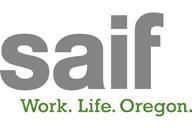
WORKERS COMPENSATION
Qualifying HBA members can save up to 7% on SAIF.
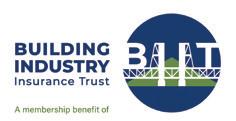
HEALTH INSURANCE
For more information, contact the Program Manager at Capital Benefits Group at 425-641-8093.
TGR General Construction Pinon, Martin 503-270-0195 General Contractor 25 New Members THANKS FOR JOINING!
Honey Bucket Gable, Jaymes 503-313-2627 Toilets - Portable
Honeywell Homes / Resideo Barnes, Thomas 503-847-1355
Security Products/Systems & Service
KNL Industries, Inc Callaway, Lillian 503-266-1130
Asphalt, Sand & Gravel
Steiner Remodel & Custom Building Steiner, Tim 503-755-5110 Remodelers
Veronica Park Properties Park, Veronica 503-250-0667 Realtors
Visual Comfort & Co. Partee, Jana 503-839-8880 Lighting Fixtures
EcoCraft, LLC Hooker, Eddie 503-577-2503 General Contractor
Evolve Design & Build LLC Sanchez, Cesar 564-206-9715 Decks - Composite Decking
Hugh Development LLC Vuong, Mark 503-926-3084 Real Estate Investment
Majic Works LLC Goodwin, Daniela 503-619-6198 Restoration - Water Damage
Portland General Contracting LLC McWilliams, Connor 831-214-2053 Builders - Custom
Roya Kitchen & Bath Farokh, Shahin 971-719-1558 Remodelers
Rupp Family Builders Incorporated Rupp, Sheena 503-828-4052 Builders - Custom
40-49 Years
Adair Homes Inc.
Loranger Builders LLC
SLS Custom Homes & Remodeling Westland Industries Inc.
30-39 Years
Clark Lumber Hardware
North West Framing Inc.
Oswego Drywall Installers Inc.
Plumbing Materials Supply Inc.
20-29 YEARS
Dave Bearson Construction Ent.
First American Title
Globe Lighting Supply Co.
Lawyers Title Insurance Co.
Lewis Audio Video Inc.
Oregon Turf & Tree Farms
Portland Millwork Inc.
Sterling & Noble Painting Services Inc.
Teal Point Custom Homes, LLC
10-19 YEARS
Blue Mountain Community Management
Canby Builders Supply
Carlson Testing, Inc
Cedar House Media
Floor Factors Inc
Ironwood Homes, Inc.
Jeff & Son’s Concrete LLC
North Clackamas Chamber of Commerce
Portland Chimney & Masonry, Inc.
Western Outdoor Wholesale
Western Pacific Building Materials
Western States Fire Protection Co.
5-9 YEARS
AIRMADA
Black Diamond Homes, Inc
Global Electric Greenwing Restorations, LLC
Guild Mortgage Company LLC
Pacific Lumber Co.
Portrait Homes Northwest
S-2 Contractors Inc
1-4 YEARS
Cambria USA
Crystal Industries, Inc.
DreamMaker Bath & Kitchen of Beaverton, Inc.
Hardman Geotechnical Services, Inc. - HGSI
LCD Excavation, LLC
Liberty Electric, Inc.
Light House Architecture and Construction
Moss Adams LLP
Pacific Timber Products
PNW Epoxy & Coating Supplies
Timberline Electrical Contractors, Inc
TS Construction Management
US Bank Home Mortgage
Washington County Chamber of Commerce
Yorke & Curtis, Inc.

Name: Mark Williams and Dawn Bell
Company: Landscaping MD, LLC
Please briefly tell us about yourself and what your company does that you’d like people to know:
Mark and Dawn are very family-oriented and this 51% Woman-owned business specializes in custom residential and commercial landscape projects.
What drew you towards becoming an HBA member?
They both love what the HBA does for the community. They had prior knowledge of
fellow HBA members and wanted to be part of the HBA family. They wanted to be part of a group that takes their industry seriously by being members of the HBA.
What are you looking to get out of your HBA membership?
Industry knowledge, solidifying existing relationships, and long-term referral partnerships.
What are your hobbies?
Mark loves team roping, hunting, and fishing. Dawn is an avid golfer.
Tell us one fun fact about you that not everyone knows:
You’ll find them every year at the Pendleton round-up with a huge group of family and friends. They have epic card games at their house often reaching up to 16 players at these games. It’s a great way to spend time with family and friends.


On September 19, the Sunrise Water Authority dedicated a building to former HBA Member and Board President, Ernie Platt, to recognize his substantial impact on the community. Following Ernie’s retirement from the Real Estate Development industry, Ernie put his practical knowledge to use as a housing industry advocate and lobbyist, working for our local HBA for another 15 years. His influence spanned even further through his longtime service on the Board of the Sunrise Water Authority, the North Clackamas Chamber of Commerce, the Wilsonville Chamber, the Clackamas Repertory Theater, and, of course, the Home Building Association, where he served as President back in 2000.
Ernie sadly passed away in the Spring of 2020. To honor his years of public service and support for housing, the HBA established a new annual award that is now presented at our Housing
Forecast event each November, The Ernie Platt Memorial Public Servant Award. The award is proudly presented to local officials who embody Ernie’s dedication to housing in the region and his commitment to public service.
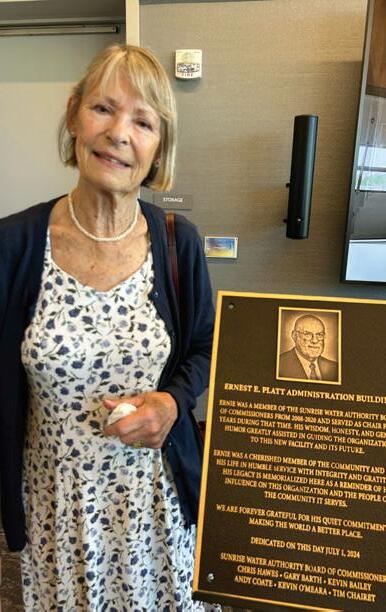
Former HBA Board President Jim Standring was present at the Sunrise Water Authority building dedication on September 19 and connected with Ernie’s wife, Pip, to express the HBA’s evergreen commitment to continuing Ernie’s commitment to housing and service in our area.
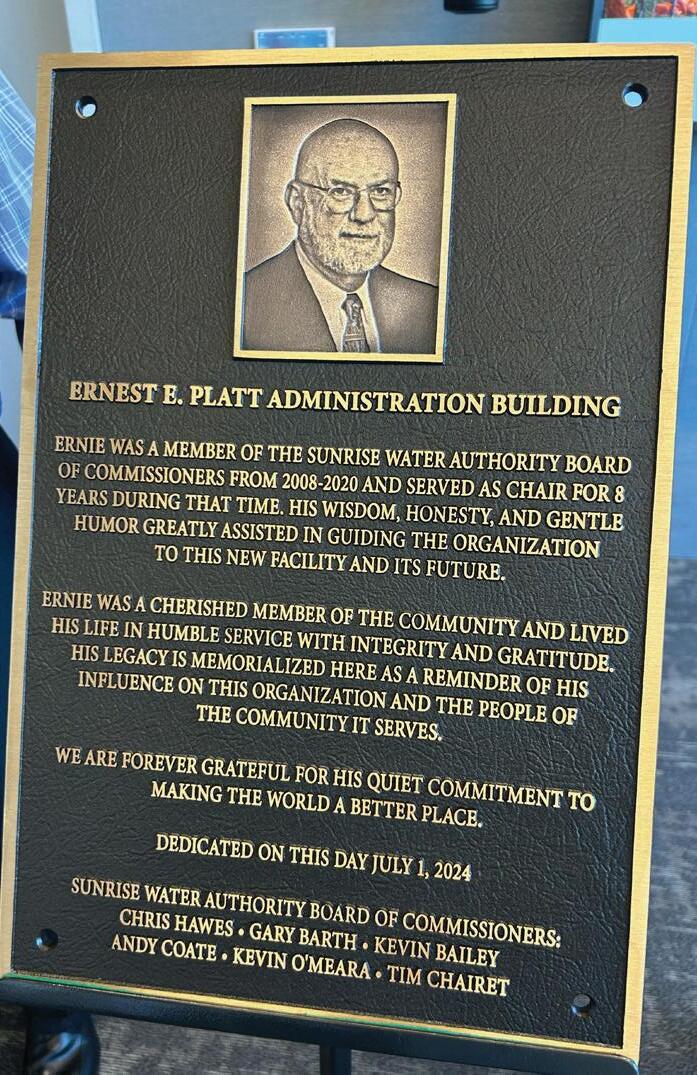
This year’s Professional Women in Building (PWB) Retreat took place on September 20-21 in scenic McMinnville, Oregon, bringing together industry professionals and leaders from the surrounding areas, including Clark County BIA and the HBA of Marion & Polk Counties. The retreat was a dynamic blend of networking, professional development, and community-building activities.
The event kicked off on Friday evening with a welcome dinner sponsored by Crandall Group and CFM at the beautiful Stillwater Event Space, setting the tone for the retreat. Dr. Jessica Lautz, Deputy Chief Economist at the National Association of Realtors® (NAR), joined us as the keynote speaker for the event and shared valuable insights into the latest market trends and what to expect economically heading into 2025.
Saturday’s agenda was packed with networking activities and breakout sessions led by industry experts. Jodi Bailey (Emerio Design) led the Business Development session, focusing on growth strategies, while Mel Duncan (Fireside Home Solutions) tackled Workforce Development, addressing recruitment and retention challenges. The Marketing session, led by Rachel Trice (HBA), highlighted innovative strategies to enhance brand presence and customer engagement.
Beyond the sessions, attendees enjoyed a walk-and-shop outing in McMinnville’s charming downtown, followed by a hospitality dinner that wrapped up the retreat on Saturday evening.
A key focus of the retreat was future planning for 2025 and discussions about the PWB Council’s priorities and goals for the coming year. Incoming PWB Chair Jodi Bailey expressed interest in hosting additional unofficial PWB Happy Hours throughout the coming year to support increased connections and engagement among members and to coordinate collective efforts to give back to the community.
A special thanks to the retreat’s
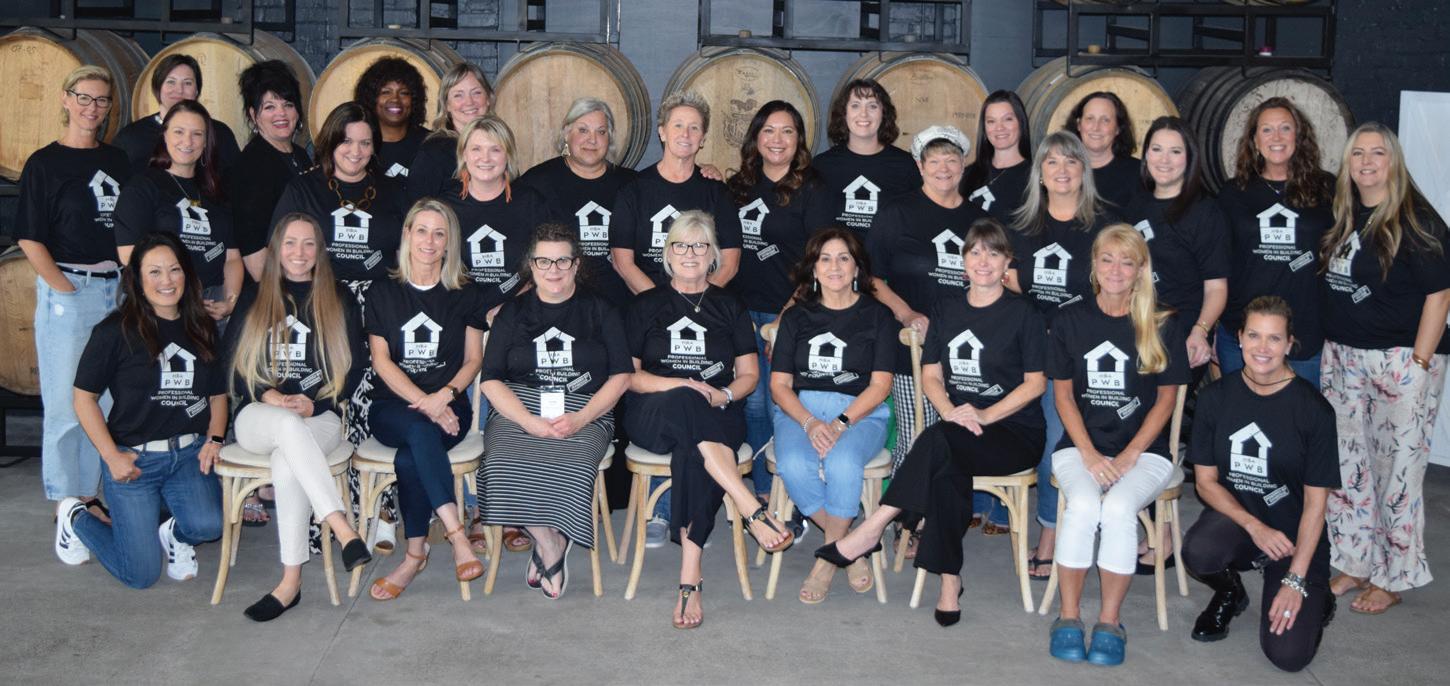


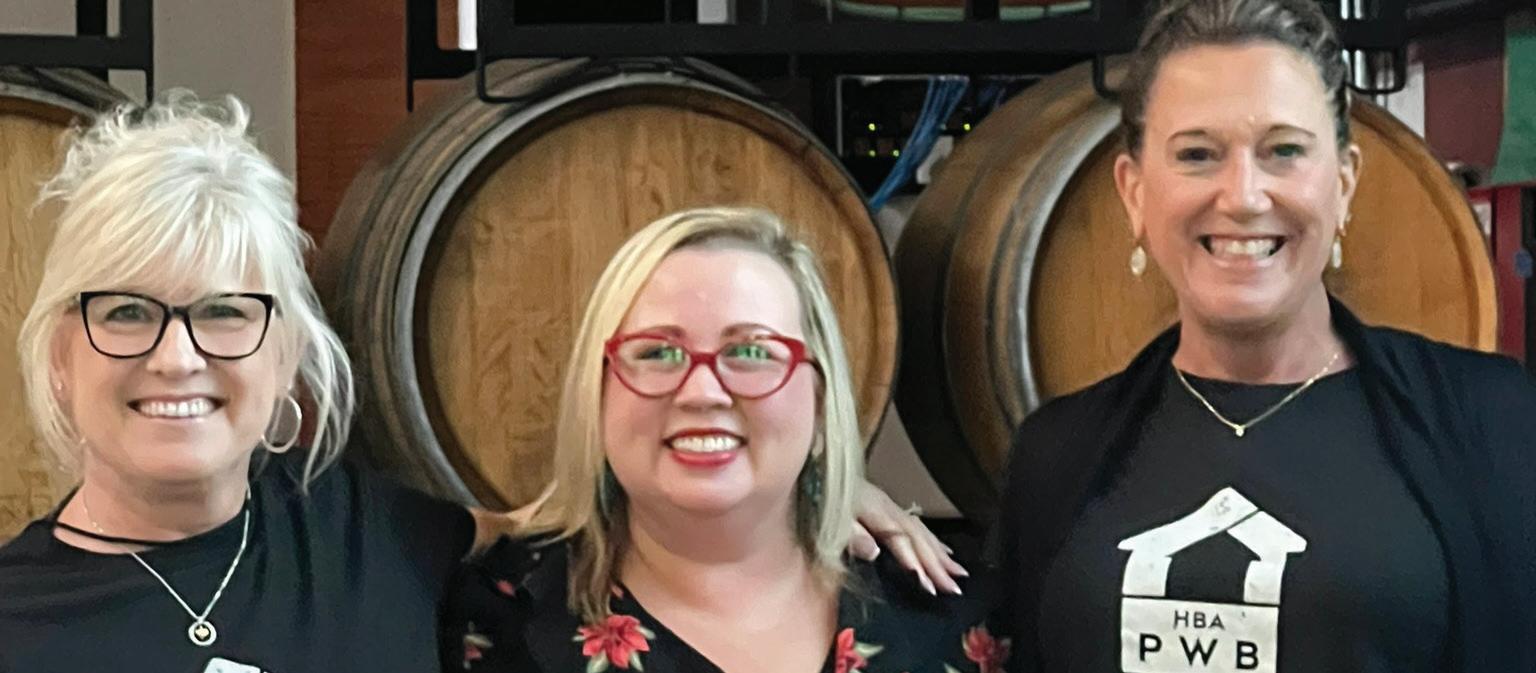
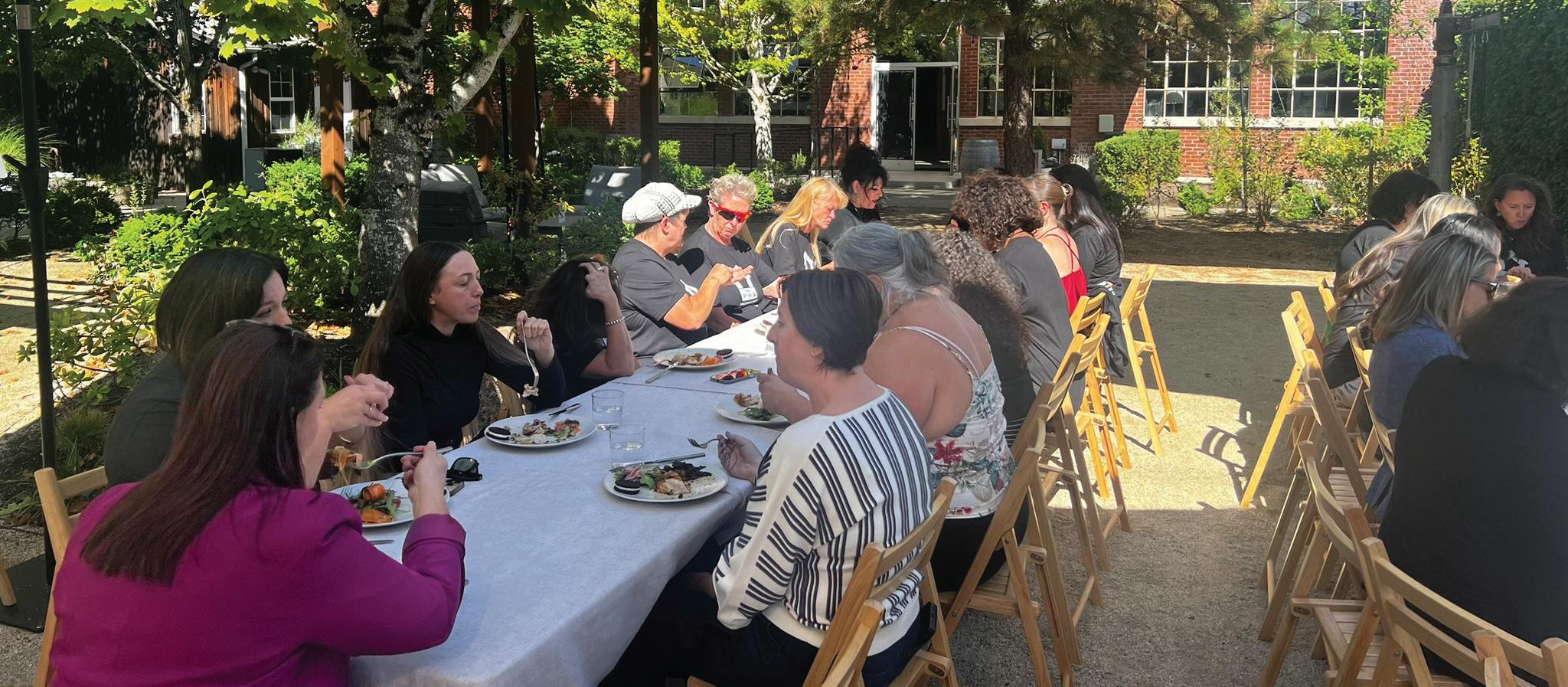
gracious sponsors: Contract Furnishings Mart, Standard TV & Appliance, Lexar Homes, Crandall Group, Fireside Home Solutions, Pennington Design Group, and Premier Central Vac for their support in making this retreat a success.
The 2024 PWB Retreat was not only
an opportunity to form new relationships and reflect on the past year’s successes but also a chance to forge new paths for 2025 and beyond. Thank you to all who attended and we look forward to seeing the exciting plans discussed come to life in the coming year!
BY: CAROL EISENLOHR, BUILDING TOWARDS BETTER LLC AND HBA BUILDING SCIENCE CONSULTANT






The 2025 BuildRight Conference + Expo is fast approaching and the HBA Building Science team is well underway planning for what we expect to be the biggest BuildRight yet. The 2024 conference opened its doors to home builders and building science experts from the entire Pacific Northwest region and the 2025 show will expand even more to include industry professionals from markets beyond just the Oregon, Washington, and Idaho regions. We are looking to our HBA membership base to help us determine what content and information the energy-efficient homebuilding industry is most interested in. We need your feedback!
Category/session suggestions are welcome! As a Building Professional, what challenges do you face in the field or your business? What educational opportunities would you like to see at the 2025 BuildRight Conference + Expo? The possibilities are endless.
Below are some categories that might interest you and your team.
High Performance Rating Systems, Building Programs & Codes
• Energy Modeling for prescriptive vs performance pathways
• Building for Incentives
• Building to the 2024 Energy Codes
• ENERGY STAR NextGen Builder
• Zero Energy Ready Home Version 2
• Code Compliance Prescriptive and Performance Pathways
High Performance Building Practices
• Building Healthier Homes
• Building Resilient Homes
• High Performance Building Envelopes
• Best Practice Implementation in the Field Management and Leadership
• Executive Management & Leadership Skills
• Small Business Development
• High Performance
Builder Success Strategies
• Construction Law and Contract Best Practices
• Marketing and Financing Energy Efficient Homes
• Workforce Development
Comfort and Air Quality
• HVAC Design, Best Practices, Sizing and Compliance
• Balanced Ventilation
• Environmental Wellness Design
• Zero Carbon & Electrification
New Innovative Home Technologies / Products
• Solar and Battery Storage Technologies
• New Innovative Energy Efficient Products
• Construction Management Softwares-3D design

The HBA Building Science Program is a technical resource available to HBA members free of charge, funded in part by Energy Trust of Oregon, Home Certified, OrePAC, Portland General Electric and NW Natural. If you would like to utilize the Building Science Program to create a continuous improvement plan focused on your building challenges or a plan to prepare for future code changes, contact Carol Eisenlohr, HBA’s Building Science Consultant at carole@ hbapdx.org or call to schedule an appointment at 503-710-2910.


HBA’s Home Performance Council & Building Science Program is bringing you a little BuildRight all year long! Join us for valuable CCB-accredited education and stay for networking with your industry peers. For questions about when the next BuildRight Road Show is scheduled, contact HBA’s Building Science Consultant Carol Eisenlohr at 503-710-2910 or buildingscience@hbapdx.org.






BY TERESA SPANGLER, HBF STAFF
The crowd had to squish to get everyone in for an historic Home Building Foundation Trap Shoot group picture. This year’s event at the Portland Gun Club is the 20th, which has grown from just 12 teams to 80 in 2024.
Some of the people who created the HBF Trap Shoot shared its backstory. HBA CEO Dave Nielsen explained they modeled Portland’s Trap Shoot after one in Sacramento, California. Nielsen admits it was a slow start but, “Everyone kind of committed to it, and within a few years, it had grown to where it is now, and it keeps growing. It’s a fantastic thing everyone is proud of it.”
Former Foundation Executive Director Mel Duncan sees the Trap Shoot as a great way to support the shelter building and education programs the Foundation provides. “Everyone has a heart for other people, for fixing things, for building things ... we were able to bring people together for a common cause, doing very wonderful things.” The opening ceremony honored Keith Steffen, who was awarded a new shotgun to thank him for serving on the committee since the inaugural shoot. He says the event is blessed, with only one rainy day in its history.
The morning begins with a delicious breakfast sponsored by Divine 9. In between hitting targets, shooters wander through booths from industry suppliers, event donors like Proletariat Butcher, as well as HBF nonprofit partners Constructing Hope, Cultivate Initiatives, and Do Good Multnomah. HBF’s Development Manger Kyle Ellerbe says the Trap Shoot is “less of a competition, it’s more like a social carnival.” To his point, there are amazing raffle prizes to win, games to play, and a delicious barbeque lunch.
Many shooters attend the Trap Shoot to win. A long line of hopefuls lined up for the mid-day Annie Oakley sharpshooter contest. Teams also compete for trophies. This year’s winners are:



• Annie Oakley Winner - Loy Russell
• Team Winner - Merten and Sons
• Women’s Team Winner - CFM Flooring
Parr Lumber’s Brian Kegg says sponsorship is a great opportunity for them. “The work the foundation does it is so aligned with
what we believe in, you are just so easy to support. To be able to network and see all of your friends and other people in the industry, it’s just a fantastic day.” For the Foundation’s bottom line, the 20th Trap Shoot hit all its marks, raising the highest gross revenue ever.
BY CHRIS MCDOWELL, HBF STAFF
Home Building Foundation and Home Building Association of Greater Portland invited the summer cohort of Constructing Hope to see the top-of-the-line home building at the 2024 NW Natural Street of Dreams. The Toll Brothers team opened four luxury homes at Hosford Farms for the tour attendees, offering stunning views and an unforgettable experience. Students wandered up and down the stairs of the three-story homes, taking in the tastefully designed rooms, and the gorgeous views of rural farmland behind the homes.
While the “wow” factor was an important part of the tour, the trainees also received valuable education from valued partners. Casey Phillips and Kira Taylor from Energy Trust of Oregon led a “lunch and learn” session to describe the building science behind the beauty.
The students also toured some more affordable housing by seeing one of three townhomes built on a 50 by 100 lot in St. Johns by Fish Construction NW. HBF found the trainees are very interested in “green” construction. Nardo Gandarella told us “I
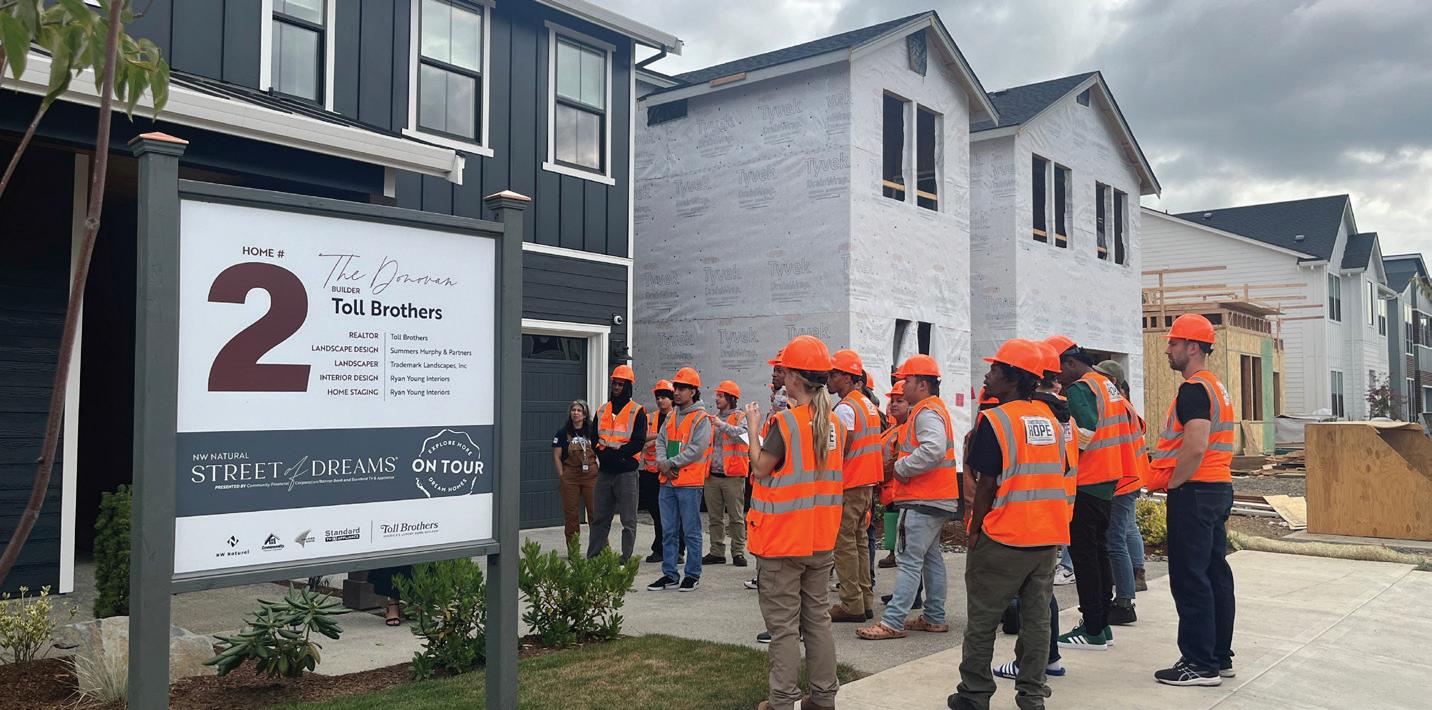
like the different types of climate controls… that was really cool”. Others mentioned they liked learning how new homes were more energy efficient.
HBF and HBA are providing opportunities to teach prospective builders about sustainable construction as a part of a multiyear grant from the Portland Clean Energy Fund. Through this grant, Constructing
BY CHRIS MCDOWELL, HBF STAFF
Smoke filled the air behind Project Homeless Connect Washington County. HBF Project Manager Chris McDowell decided that he’d rather fire up a grill than organize a ribbon cutting to celebrate the completion of extensive remodeling of PHC’s buildings. For the wrap-up party, McDowell grilled about 50 burgers and countless hot dogs to feed the folks who come each day to the “Yellow House” in downtown Hillsboro. HBF and volunteers have been working to improve the busy shelter for more than two years.
Many of the guests we served told HBF how much they appreciated the wonderful meal. Kim Marshall of Project Homeless Connect said “It is impossible to put into words how thoughtful a partner they are,
which was highlighted by the delicious food for our friends, staff, and volunteers”.
The celebration was also attended by Hillsboro Mayor Steve Callaway, members of the PHC board, and HBF supporters. Project volunteers from Constructing Hope and Rick’s Custom Fencing and Decking came to see their work come to good use. HBF took the opportunity to bring 150 hygiene Care Kits for dinner guests and cat and dog food for clients with pets. For PHC’s Kim Marshall, the event was an ideal way to “recognize the power of community partnership and everyone who made the renovations possible”. The Access Center offers meals, laundry, showers, counseling, housing placement, and companionship to as many as 100 people each day.
Hope, Oregon Tradeswomen, Portland Opportunities Industrialization Center, and Portland Youth Builders trainees receive enhanced building science education to encourage people most affected by climate change to learn how to improve their communities. All of the training programs focus on low-income participants, most of whom are people of color.
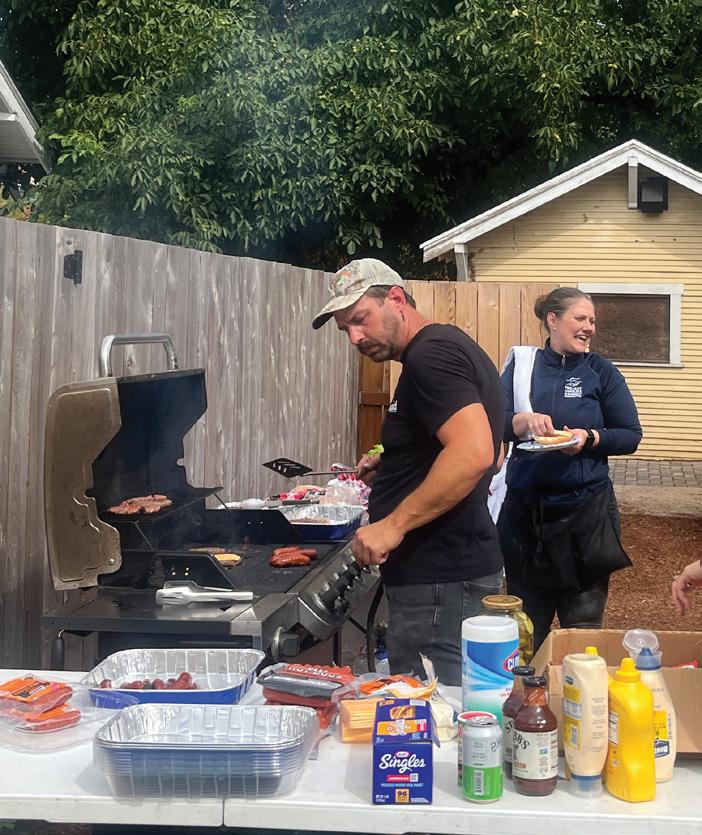





The Home Building Association of Greater Portland has partnered with Regence BlueCross BlueShield of Oregon and Capital Benefit Services to bring members more affordable health care through the Building Industry Insurance Trust. HBA members deserve a health plan that's tailored to your industry and focused on the well-being of your employees and your business. Powered by the most trusted name in health insurance, your plan offers access to a broad provider network and support from an award-winning customer service team.
To learn more or get a quote, visit buildingindustryinsurancetrust.com or call (425) 641-8093.
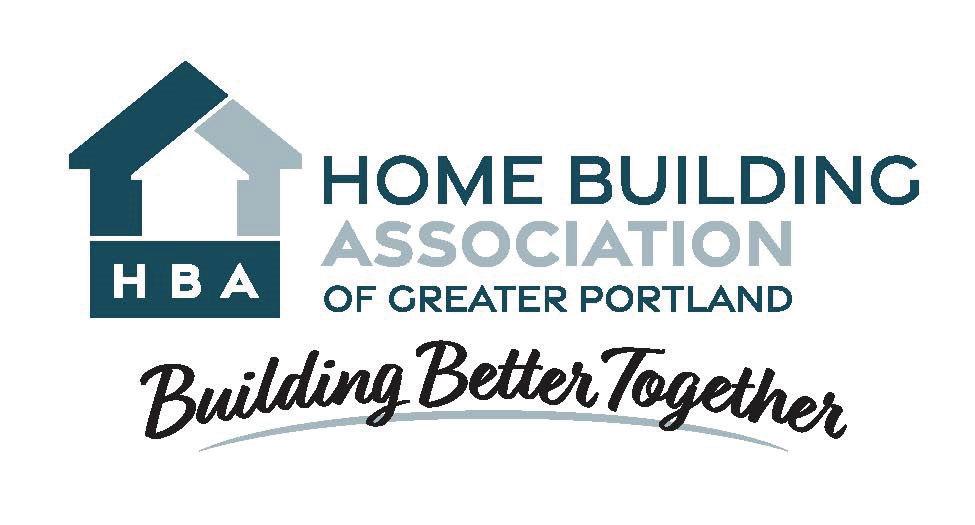
Connect with us at HBApdx.org
November 5, 2024 General Elections
Please visit HBA’s website for more updates and information on our endorsement in the City of Portland’s election for mayor and council.
Clack County Commissioner Chair: Tootie Smith (i) www.tootiesmith.com
Clack County Commissioner: Melissa Fireside firesideforclackamascounty.com
Wilsonville Mayor: Shawn O ’Neil shawn4wilsonville.com
Hillsboro City Council: Elizabeth Case elizabethcase.com
Hillsboro City Council: Rob Harris electrobharris.com
Tigard City Councilor: Maureen Wolf (i) maureenwolf.com
Tigard City Councilor: Jeanette Shaw (i) shawfortigard.com
Tigard City Councilor: Faraz Ghoddusi www.ghoddusi.org
Tigard City Councilor: Gabe Velasquez gabevelasquez.com
Tigard City Councilor: Jake Schlack (i) Jake_Schlack
Hillsboro City Mayor: Beach Pace (i) electbeachpace.com
District 1: Vadim Mozyrsky votevadim.com
Multnomah Co. Commissioner: Meghan Moyer meghanformultnomah.org
Gresham City Councilor: Sue Piazza (i) votepiazza.com
Gresham City Councilor: Kayla Brown votekaylabrown.com
Gresham City Councilor: Cathy Vandehey Keathley votekeathley.com
McMinnville City Mayor: Remy Drabkin (i) remy-drabkin
Yamhill County Chair: Lindsay Berschauer lindsayforyamhillcounty.com
For more information on HBA ’s endorsements, contact Preston Korst, Director of Policy and Government Affairs at prestonk@hbapdx.org
HBA has been involved in several workgroups assessing the path to reforming Metro’s Supportive Housing Services Measure, the tax passed in 2020 that funds homeless services through the counties. The current program collects a 1% tax on all taxable income of more than $125,000 for individuals and $200,000 for joint filers. It also collects a 1% on profits from businesses with gross receipts of more than $5 million.
The basic goal of the exploratory group meeting with Metro leadership has been to address the serious issues of the SHS program and tax that have arisen in the last several years, particularly the lack of accountability at the local level, the inability of counties to spend resources on basic services, and the growing problem of unsheltered camping in public spaces. So, for the last six months, Metro has gathered several stakeholders (HBA included) to vet proposals to reform the measure to make it more effective, with the added benefit of potentially lowering the region’s tax burden. The current tentative agreement being worked out calls for several reforms to the measure, including:
• Greater oversight of county programs, including how and where money is being spent, and more accountability in creating shelter beds and actually reducing homeless populations.
• Transferring any and all excess revenue (which has topped hundreds of millions) to the creation of affordable housing development, including innovative capital projects that support greater housing affordability.
• A potential reduction in the tax rate for individuals, including a one-time increase to the income eligibility thresholds with annual inflationary indexing.
• Extending the tax’s sunset from 2030 to a later date, in order to ensure the long-term funding mechanism is more assured to county operators of homeless services.
HBA is proud to officially join the campaign to defeat Measure 118, an initiative being funded by out-of-state donors that will appear on Oregon ballots this November. Measure 118 is a gross receipts tax on businesses with more than $25 million in annual Oregon sales. In other words, it’s a tax on sales – not profits or income. That means businesses in Oregon would be forced to pay this new $6.8 Billion tax on the goods and services they provide, regardless of whether they make a large profit, make a small profit, or are losing money. Measure 118 would force hundreds of local businesses to raise their prices, cut jobs, or shut down completely.
We are fortunate that most State elected officials, including the Governor and the leadership of the House and Senate, have come out against this. However, given the fact that the proponents are essentially promising “free” money, we’ll need to make the case that this is bad for business, bad for the economy, and will ultimately raise prices on everything—including gas, groceries, and housing.
Following the voter-rejected UGB expansion previously approved by North Plains City Council, the city is moving forward with what’s being called an expansion “Re-Look”. This summer, North Plains City Council deliberated and approved a new plan that will establish an Advisory Committee to help advise and develop a new approach to growth. This “relook” will focus on creating greater opportunities for public involvement to determine a new development plan for the expansion planning efforts. HBA and our partners are meeting with Council and City leadership to ensure that any planning body considers the desperate regional need for new housing and employment opportunities.
Additionally, and concurrently with the plan being developed by City Council, HBA’s involvement in a city-led legal challenge defending its expansion process (prior to May’s vote to reject it outright) ultimately failed. Washington County Circuit Court judge issued a ruling that decided against rejecting May’s election results, and limiting the constitutionality of HB 4026, a bill HBA and our partners across the state championed last session. HBA joined the case via an amicus brief, arguing that the court should also weigh in by deciding that cities’ UGB’s land-use decisions are in their very nature administrative (rather than legislative), and therefore not allowed to be put to a referendum. While the judge did not weigh in on that particular issue, he did effectively end any hope that North Plains’ initial work to expand their UGB would stand on its own legal merits. It also appears uncertain whether he addressed the state legislature’s authority to apply HB 4026 to future UGB decision-making processes, which would effectively prevent UGB votes from being put to a vote via local referendum or petition.
On August 28th, Portland’s City Council approved a small but important technical change to the way that affordable homeownership projects are approved. Following a year of joint advocacy in Salem between Portland’s Government Relations team and HBA, Council voted to streamline the city’s HOLTE program by giving Portland’s Housing Bureau the authority to approve builder applications for homebuyer affordability exemptions. In the past, as mandated by state law, City Council was required to approve each project application through a resolution prepared by the Housing Bureau. The old process added unneeded time to get affordable homeownership projects started in the city. This change has the potential to help builders save weeks (potentially months) in development timelines for projects accessing the tax abatement exemption. This is a small fix, but an important one to help our members remove unnecessary delays in getting housing built more quickly in Portland.
The City of Gresham is working on several concurrent projects aimed at streamlining the development code and offering clarity to housing application requirements in the city. The changes are meant to be targeted and update the tree code and stormwater facilities, residential design standards, and public works standards. This project has been an ongoing conversation with builders that the City of Gresham hosts at its monthly development forum meetings. Areas of particular interest are how to encourage more street tree success among the city’s budding middle housing projects, while also ensuring that single-family homes are not being adversely impacted by state-required application standards.

For the last year, HBA has provided input and engaged with the County’s LUT team to help shape the county’s Significant Natural Resources Project. Stemming from several years of legal scrutiny regarding clear and objective standards, the county has created two ordinances (Ord. No. 901 and No. 902) to come into compliance with state law. This includes updates to its mapping tools for natural resources including replacing outdated maps with newer, though inexact, maps using GIS from Metro. Additionally, there are also proposed changes to the development code related to tree removal permitting, design standards, and added standards for Riparian Habitat and Upland Wildlife Habitat, including adding classes of protection. Having proceeded through the Planning Commission last week, the project has reached a significant milestone. The current ordinances include several important details, including a proposed rule exemption for any properties of less than 2 acres, which was formally recommended by the Planning Commission last week. HBA is now
working with the County Commission and has written testimony advocating for additional exemptions to be granted to projects on smaller/challenging lots, in addition to offering opportunities to allow off-site mitigation options.
HBA Advocates for high-growth and Sherwood West in Metro’s 2024 Draft Urban Growth Report Comment Period
On August 22nd, HBA submitted its first letter of testimony on Metro’s 2024 Draft Urban Growth Report (UGR) outlining our vision for a strong growth forecast and speedy approval of the City of Sherwood’s UGB expansion request. The UGR is a foundational planning document that provides important data and analysis predicting our region’s housing and employment land supply needs. Required by state law every six years to forecast local population growth and measure regional land capacity, this report is used to guide Metro Council’s policymaking on a host of issues, chiefly for Urban Growth Boundary (UGB) decisions.
For nearly a year, HBA has had a seat at Metro’s UGR Stakeholder Roundtable, where roughly 20 advocates from a variety of sectors explored and debated the ongoing technical aspects around our region’s growth trends for housing and employment land needs. Following this, and with input from stakeholder testimony, Metro’s Chief Operating Officer released her recommendation to the council on how they should proceed with their growth management decision. Her recommendation, provided with great detail of context, outlined a justification for just enough land to support the approval of Sherwood’s UGB request but stated that no more land was needed to accommodate growth.

HBA’s testimony asks Metro Council to go beyond the COO recommendation, and encourages a high-growth modeling to encourage more inclusive view of our regional land needs. Over the next month, HBA will be working closely with our partners in the business community to ensure that the region’s economic vitality is considered by council as they deliberate how to proceed.
BY ENERGY TRUST OF OREGON
Earlier this year, Energy Trust shared anticipated changes in the upcoming 2023 Oregon Residential Specialty Code (ORSC) and announced that EPS New Construction will use the updated code as the baseline in 2025. This article explains the logistics of that transition and what to expect in 2025.
EPS New Construction 2024/2025 timeline:
• December 6, 2024 will be the last date to submit homes for review under the 2021 ORSC.
• Throughout December 2024, program staff will review and process incentives for homes submitted prior to the
deadline and using 2021 ORSC.
• In mid-January 2025, EPS New Construction will begin accepting new homes using the 2023 ORSC as baseline.
If you have a home that was permitted under the 2021 ORSC, be sure to work with your verifier to submit your home by December 6, 2024.
Program changes in 2025:
• Due to stringency of the new code, the entry threshold for new homes will decrease from 10% above code to 5% above code.



• Homes will still be eligible for bonus incentives for solar ready, net zero, EV ready/charger install, solar + storage ready, as well as homes that meet affordable, rural and/or tribal criteria.
Attend the BuildRight Road Show on November 7th in Hillsboro, Oregon to learn about the 2025 program and how to exceed code requirements for 2024. For more information and to RSVP, please contact Carole Eisenlohr at carole@hbapdx. org. If you have questions about the baseline transition, please reach out to eps@energytrust.org.


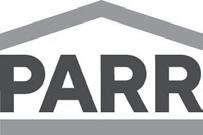







BY REGENCE
Starting a new prescription medication can feel mysterious. Before you even start taking the new drug, you may wonder: Is it safe to use? Will it work well? And will it cost just a few dollars, or take a bite out of my monthly budget?
You may not be aware of it, but your health plan has already posed these important questions to health care experts. It’s part of the process for creating and managing a drug formulary, the framework that guides your pharmacy benefits.
“A formulary is simply a list of prescription medications approved for coverage by your health insurance,” explains pharmacist Noelle Redmond, assistant director of clinical pharmacy services for Regence BlueCross BlueShield. “The approved list reflects the drugs that are covered at various levels, with certain ones being preferred for reasons of safety, efficacy or cost.”
Experts like Redmond spend a lot of time reviewing scientific research and gathering information about the prescriptions that are on a health plan’s formulary. Their main goal is to make sure the approved drugs work well and are widely considered safe to use.
If a treatment isn’t on the list, it’s considered “nonformulary,” which usually means higher out-of-pocket costs or no coverage for the medication.
A formulary can include name-brand and generic drugs. At Regence, the price of a medication is only considered after the pharmacy team concludes that it is safe and effective, Redmond adds. “We’re only going to look at cost if everything else is equal.”
Health plans create their drug formularies based on medical research and input from specialists. Before they get to that point, however, the medication has to be considered a covered service. Coverage decisions are made based on an agreement between your health plan and the organization that you get health insurance through (usually an employer or a government program like Medicare or CHIP). Federal and state regulations also play a role.
“When you or your employer group has insurance, it is actually a contract with the health plan,” Redmond says. “There are rules in there, which you can find in the plan description that gets sent to members.”
For example, drugs for weight loss are not a covered service, so you wouldn’t find them on a health plan’s approved list. Once a medication is included as a covered service, however, it can be considered for the formulary.
Recommendations for what goes on the list are made by a group called a pharmacy and therapeutics (P&T) committee. Each health plan or hospital system has its own committee, composed of doctors, pharmacists and other experts who review medication data and make formulary recommendations.
Regence’s P&T committee also includes consumer representatives, nurses and doctors who practice in the communities it serves. These committee members aren’t affiliated with the health plan, ensuring
their independence in the process.
Pharmacists on Regence’s medication research team compile and analyze information to share with the P&T committee. They come from a variety of backgrounds, too. Some, like Redmond, have worked in community health. Others are from hospitals or cancer specialists or have expertise in pharmaceutical development. Redmond says this allows the committee to take a “humanistic approach” to its formulary.
How does a medication get approved?
The P&T committee builds its list of approved medications by closely tracking:
• How well the drug works (efficacy).
• Any potential risks or side effects (safety).
• Whether it’s widely used (standard of care).
• The needs of patients, including health equity and whether alternative drugs are readily available (practical considerations).
• The medication’s price and how it relates to overall health care costs (cost).
The process is ongoing, as drug formularies can change over time. To ensure that its list remains up to date, Regence routinely updates its formulary to reflect new drug approvals, changes in the market, and the latest information about safety and effectiveness.
When a formulary change is likely, member advocates like Kristen Lilley step in.
As Regence’s pharmacy consumer experience manager, Lilley’s job is to anticipate how a given update will affect people’s prescription benefits, and to help smooth the way.
“I focus on really putting a member-centric perspective on formulary changes that are coming up,” she says. “I make sure I’m understanding the disruption and how to communicate to members who are affected to help them navigate it.”
How does FDA approval fit in?
Your health plan’s P&T committee makes the ultimate decision about the formulary’s contents, so what role does the U.S. Food and Drug Administration play?
The FDA approves drugs for safety and effectiveness. This alone isn’t a guarantee that a given medication will be included on your formulary, though. Each insurance company does its own analysis of scientific research, medical guidelines and pharmacy policies before deciding if a treatment should be covered.
In other words, while FDA approval means a drug has met certain standards, it doesn’t mean the medication is necessarily covered under your health plan or the best or most cost-effective option for your specific needs.
It’s also important to know that the clinical testing required for FDA approval doesn’t include every type of person who might use the treatment once it’s widely available in the marketplace.
Often, clinical trials involve fewer than 1,000 patients who are observed for six months or less, a 2017 Yale University study found.
BY REGENCE
This means that side effects may become clear only after the treatment is used on a larger population. In fact, the Yale study found that in the decade after approval, the FDA announced alerts, warnings or recalls on about one-third of the drugs it had approved.
Drug formularies generally use a tiered system to set the cost of medications for your health plan.
The system categorizes drugs into different levels based on the type of medication and its overall value. Patients’ cost-sharing responsibility (copay or coinsurance) rises with each level. There can be three to six tiers, though four is a common structure. The categories generally fall along these lines:
• Tier 1: Generic drugs.
• Tier 2: Preferred brand-name medications. These may not have a generic equivalent but are still cost-effective.
• Tier 3: Nonpreferred brand-name drugs, which have a higher cost-sharing expectation.
• Tier 4: Specialty medications. These have the highest level of cost-sharing.
The tiering system encourages the use of the highest value and equally or more effective medications when possible. This helps address both individual needs and the overall cost of health care. Understanding how it works can help you save money on prescriptions, too.
As Redmond and Lilley note, the formulary has to strike a delicate balance, making sure that members get effective treatments and that premiums don’t rise too fast. They do so by creating a system of checks and balances along the way.
“We don’t operate in a vacuum,” Redmond says. “We’re really trying to pay attention to the human at the end of the equation. We get expert feedback all along the way, and our final approval body is composed of people who don’t work here. This is our way of making sure that we’ve got it right, and that we’re validating our recommendations with the people who actually take care of patients.”
For her part, Lilley highlights how much this is a collaborative effort at all levels. She lives in a small mountain town, and when she runs into friends and neighbors, they often share stories about being frustrated with their prescription benefits. When she explains Regence’s formulary process, they’re surprised to find out how many people are involved in developing the list.
“I tell them all the time, there are people inside of Regence that continually champion members. Our full-time job is to make sure that we’re leaving nobody behind and there’s a voice at the table when decisions are being made.”
Still have questions about your medication coverage? Get answers at any time through the Ask a Pharmacist tool in your regence.com account.
You can find other ways to manage prescription costs on regence.com.
BY: JOE SEIFERT, DELAP LLP
The Corporate Transparency Act (CTA) became effective January 1, 2024, with the goal of combatting money laundering, terrorist financing, corruption, tax fraud, and other illegal activities. The act mandates that certain U.S. entities file a Beneficial Ownership Information (BOI) Report with the Financial Crimes Enforcement Network (FinCEN).
The BOI Report must include:
• For the reporting company: Full legal name, alternative names, federal tax ID, jurisdiction of formation, and current address.
• For the individual beneficial owners and company applicants: Full legal name, date of birth, current address, and a copy of a government-issued photo ID.
Entities required to file these reports
include domestic reporting companies, such as corporations and LLCs formed by filing documents with a state office, as well as foreign reporting companies doing business in the U.S. However, certain entities are exempt, including SEC reporting companies, regulated financial services, insurance companies, PCAOB-registered firms, tax-exempt entities, inactive entities pre-dating January 1, 2020, and certain large entities with over 20 fulltime employees, a physical U.S. office, and over $5 million in gross receipts or sales in 2023.
If your company is a “reporting” company, the first step is to identify your beneficial owners— typically anyone owning 25% or more of the company or having substantial control. Then create and maintain an accurate Beneficial Ownership Register and make required report filings.
Filing deadlines:
• Companies existing before January 1, 2024, must file by January 1, 2025.
• Companies created on or after January 1, 2024, must file within 30 days of creation.
• Updates to previously reported information must be filed within 30 days of any change.
Non-compliance may result in fines or penalties. Establishing a compliance program to handle these requirements is advisable.
Delap can assist in identifying beneficial owners, setting up compliance procedures, and providing guidance tailored to your needs. However, consulting with corporate law and regulatory compliance experts is highly recommended to navigate these new CTA requirements. Also, we could see significant changes regarding the status of this act in the near future, so be sure to check the latest news before making any changes.
Please reach out to Jill Tichenor (jtichenor@ delapcpa.com) with Delap Business Advisory for any questions you may have.
BY BRAD NANKE, OHBA
National Preparedness Month, sponsored by the Federal Emergency Management Agency and held annually in September, is a good reminder that natural and manmade disasters can strike at any time. It’s important to have a planned response when you’re at work, on vacation or on the road.
Over the last few years, weather-related deaths are up 35% from 2017, while the number of weather events have increased 7% and injuries have decreased 15%. In 2021, 61,105 weather events resulted in 974 deaths and 1,667 injuries. Winter weather, heat, and floods were responsible for the most deaths during 2021. The largest number of reported injuries resulted from tornadoes, winter weather, and high winds (including thunderstorm winds). The most deadly weather events in the United States over the past few years include Hurricane Irma, the 2021 drought and heat wave, and the California wildfires.
The National Safety Council offers safety tips specific to each of the following emergencies:
• Earthquake, Flood, Hurricane, and Tornado
Federal agencies, like Ready.gov, the National Oceanic and Atmospheric Administration, and the Centers for Disease Control and Prevention, also are valuable resources for emergency preparedness.
When you face a natural or man-made emergency, try to stay informed through radio, TV, or the Internet. In some cases, however, cable, electric, and cell phone service will be disabled, making communication nearly impossible. The National Safety Council recommends the

following general precautions that apply to many disaster situations:
• Make sure to have a family/ employee communication plan in place; all members of the family or employees should review and practice the plan.
• Have all family members’, employees’, and other important phone numbers written down or memorized.
• Have an emergency kit in your car and at least three days of food and water at home
• Be sure to store all important documents – birth certificates,

insurance policies, etc. – in a fireproof safe or safety deposit box.
• Assign at least one family member or employee (preferably many) the responsibility of learning first aid and CPR.
• Know how to shut off utilities.
From weather-related issues to active shooters, it’s critical for employees to know what to do before, during and after an emergency.
Visit https://www.nsc.org/home-safety/ safety-topics/emergency-preparedness for tips, plans, and training materials.
















